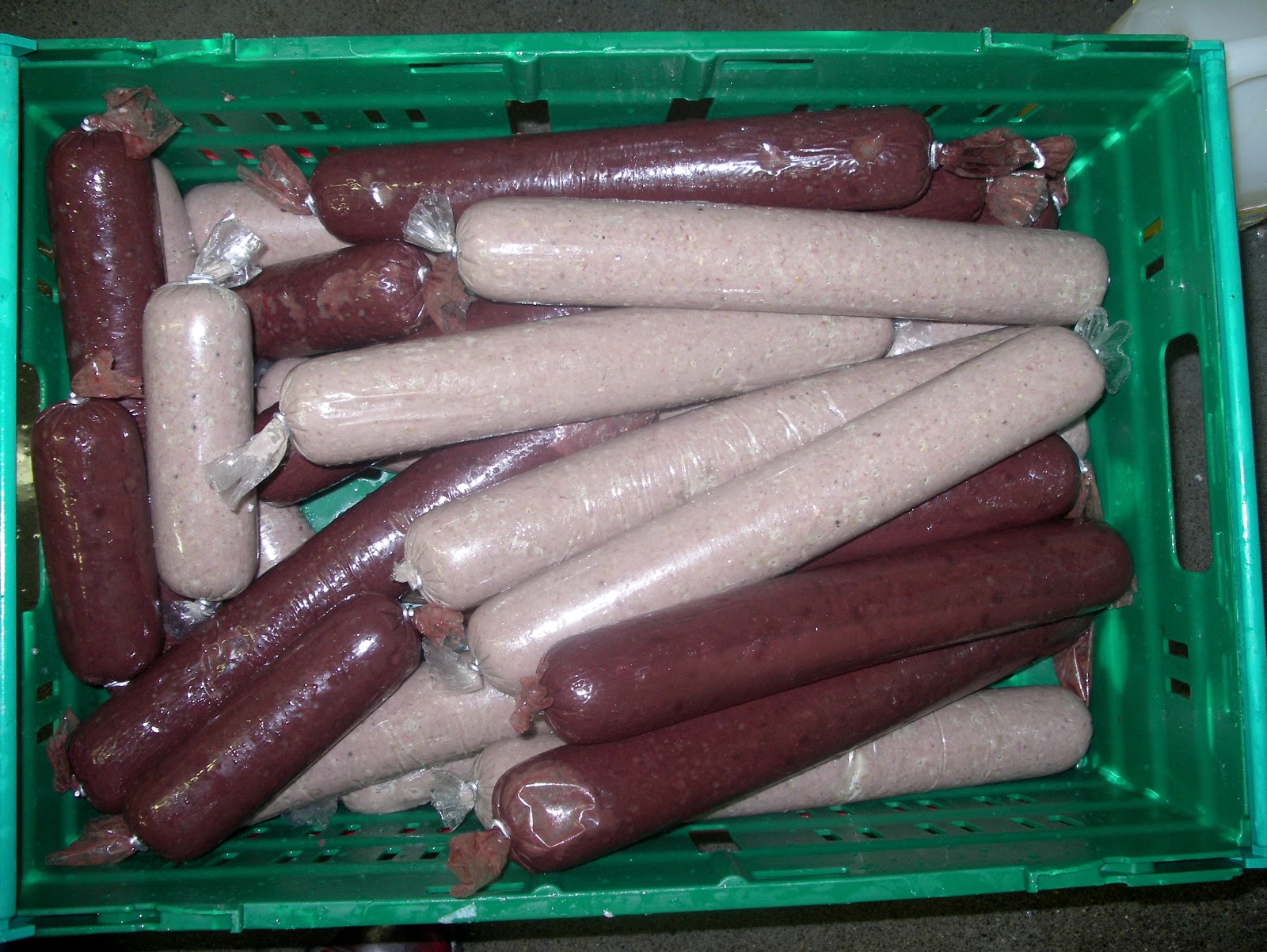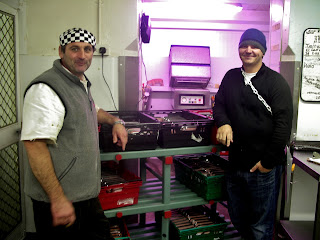For the
month of September, on top of their regular farmers’ market at Dublin’s Temple Bar, Sarah and
Patrick take the Gallic Kitchen market trailer to the Farmleigh farmer’s
market located in Phoenix Park in Dublin.
In 1662, when Ireland
still officially belonged to England,
the 1752 acres of land, now called Phoenix
Park, was purchased to
house the royal Viceroy of Ireland. Its
expansive grounds, enclosed within a stone wall, originally functioned as the
royal deer park. The single largest enclosed park of any
European capital city, Phoenix
Park is now a national
landmark containing the residences of the President of Ireland and the United
States Ambassador, among other historic monuments, and remains a lush sanctuary
to many birds and animals.
Anyway,
as a designated driver, one of Jonathan’s duties was to transport Sarah’s freshly made wares the hour and a half drive up to Dublin for the Farmleigh
Farmers’ Market; no need to work the market as Patrick’s
nephew, Anthony, had that under control.
The market started at 10:00 a.m. and finished at 5:00 p.m., which gave
us a good seven hours to kill in Dublin;
a real hardship, let me tell ya.
Being the
whiskey girl that I am, I insisted that our first outing in Dublin be to the old Jameson Distillary, established
in 1780 but now only an historic venue as the actual whiskey is now distilled at the Midleton Distillary in County Cork. Even though the tour was a little
pricy at €13 a pop, we still signed up knowing that at least we would get a “free” shot of
Jameson at the end of the tour. Ignonore the fact that it was only 11:00 a.m., we’re on vacation! While we waited for the tour to begin, we
browsed the gift shop, almost buying expensive Jameson chocolates, a Jameson flask, a
classy set of leather Jameson coasters, among other over priced items before
settling on a €5 deck of Jameson cards.
On to the tour itself. It began with a hokey ten minute video about
a reporter who is late for his interview with Mr. Jameson. In trying to find Mr. Jameson, the reporter is consequentially
led on a tour of the distillary as every scene finds him to be just one step
behind Mr. Jameson. At the end of the “tour“,
he finally finds Mr. Jameson who offers him a shot of the famous triple
distilled whiskey. Upon sipping the
magical liquid, the reporter hears music from the heavens and for a moment
thinks that he sees an angel surrounded by a bright glowing light. Like I said, hokey.
Our overly
excited guide then led us on our own tour of the “distillary“, rooms designed to
replicate the steps of the whiskey making process. I knew it was going to be a long day when in
the first room, which displayed the barley store rooms, the guide pointed at a
stuffed cat that looked like the work of a blind taxidermist on LSD and
enthusiastically told the story of the “legendary” cat who was rumored to have
been the factory’s record mice catcher.
Good lord. The actual process was
quite interesting (sprouting the grains, drying them over hot coals, adding
yeast and water before triple distilling the liquid to make a smooth finished
product); however the overall experience was killed by the ridiculously camp
delivery and nice but very unfunny guide.
No wonder they give you a shot of whiskey at the end; trust me, you need
a little pick me up just to forget the last half hour and feel normal again. My advice?
Save your €13, go buy a 350ml bottle of Jameson, and drink a glass or
two while you read about whiskey making on Wikipedia. I’m just sayin’.
As the
tour came to a close and the time for our free shot arrived, the guide asked if
there was anyone out there who would like to participate in a demonstration and
drink more than their allotted shot.
PigWizard and Baby Bird’s hands shot up, duh. We first chose our preferred poison along
with the others, Jameson straight up for me and Jameson & ginger ale for
Jonathan, before being seated at a banquet table with the 6 or so other
demonstration volunteers.
Arranged
on a place mat in front of each person was a glass of water and three plastic
shot glasses filled with about a half ounce of brown liquid. Clearly a whiskey tasting was in order. During the tour, the guide had talked about
crowd pleasing smoothness of Jameson whiskey which is a direct result of the
triple distillation process through which each drop of Jameson passes. She also explained that due to amount of
smoke to which the barley is exposed during the drying process, Scotch whiskeys
tend to have a smokier flavor than Irish whiskeys. American whiskeys are aged in casks made of
young wood as opposed to the older casks used for Irish and Scotch whiskey,
which of course affects the flavor of the finished product. Predictably, the glasses in front of us were
a sample of each: the glass on the left was the most popular (i.e. best
selling) Scotch whiskey, Johnny Walker Black Label, the glass on the right was
the most popular American whiskey, Jack Daniels, and in the center was the most
popular Irish whiskey, of course, Jameson.
We were
instructed to smell the Jameson and take a small sip…smooth. Sip of water.
Smell the Johnny Walker Black Label and take a small sip…stronger and
quite smoky in comparison. Sip of
water. Sip the Jameson…ahhhh,
smooth. Sip of water. Smell and sip the Jack Daniels…bleh, too
sweet (which is hilarious because not that many years ago, my drink of choice
was Jack and Diet Coke, both of which are far to sweet for my taste buds of
today). It was a fun little exercise,
especially comparing the smokiness of the Scotch to the smoothness of the
Jameson. I left the remaining bit of Jack
Daniels and tossed back the rest of my Johnny Walker and the tour was complete.
On our way
out of the factory, we stopped in the whiskey tasting room just to see what we
could see. Jonathan’s buddy and the
owner of The Cheese Shop in Carmel,
Kent Torrey,
had recommended that we sample Midleton Very Rare Irish whiskey. Heck, we’re in the whiskey tasting mood, why
not? At €22.50 per glass, we
shared one. Pricy, yes, but also
incredibly mouth coatingly delicious. At
€140 a bottle, and not available in most American liquor stores, Midleton
definitely qualifies as a special occasion whiskey.
We chatted
with the bartender, learning a little more about the differences in Irish
whiskeys, before finally probing him for a restaurant recommendation, something
a little special but not to hard on the old pocket book. As we exited the tasting room, heading to
Mulligan’s, a shiny glass case caught my eye:
 |
Complete Collection of Midleton Very Rare
“Ireland’s
Most Exclusive Whiskey”
Dating From Its Creation in 1984 to The Current Vintage
€50,000.00
|
 With
visions of Middleton Very Rare dancing in our heads, we went in search of
Mulligan’s for a bite to eat. With
Jonathan’s handy dandy iPhone, we did not have to search long; in fact the
restaurant was only a few blocks from the Jameson Distillery. We walked into a dark pub with old wooden
furniture and what looked like 75 different beers, a dozen or so on tap. Our waiter handed us our menus, two antique
books with the printed menu wedged in the center. Unable to pass up the chance to choose from
75 beers, I forced myself to stray from my one and only (Guinness) and instead
went for an O’Hara’s stout (it was just the once, Guinness, I promise!). Not as thick as Guinness but even deeper in
flavor. Yum.
With
visions of Middleton Very Rare dancing in our heads, we went in search of
Mulligan’s for a bite to eat. With
Jonathan’s handy dandy iPhone, we did not have to search long; in fact the
restaurant was only a few blocks from the Jameson Distillery. We walked into a dark pub with old wooden
furniture and what looked like 75 different beers, a dozen or so on tap. Our waiter handed us our menus, two antique
books with the printed menu wedged in the center. Unable to pass up the chance to choose from
75 beers, I forced myself to stray from my one and only (Guinness) and instead
went for an O’Hara’s stout (it was just the once, Guinness, I promise!). Not as thick as Guinness but even deeper in
flavor. Yum. In
perusing the culinary choices that Mulligan’s had to offer, I came across a
Scotch Egg. What the heck is a Scotch
egg? Never having experienced a soft
boiled egg wrapped in sausage then breaded and deep fried, we ordered one as an
appetizer. Served on a wooden board and
perched on a bed of greens, the Scotch Egg looked beautiful! And I must say, taste-wise, I was not
disappointed. Of course the mind started
to run away…imagine breakfasting on a soft boiled egg wrapped in PigWizard’s
chicken sausage with poppy seeds and candied orange rind!
In
perusing the culinary choices that Mulligan’s had to offer, I came across a
Scotch Egg. What the heck is a Scotch
egg? Never having experienced a soft
boiled egg wrapped in sausage then breaded and deep fried, we ordered one as an
appetizer. Served on a wooden board and
perched on a bed of greens, the Scotch Egg looked beautiful! And I must say, taste-wise, I was not
disappointed. Of course the mind started
to run away…imagine breakfasting on a soft boiled egg wrapped in PigWizard’s
chicken sausage with poppy seeds and candied orange rind!
For my
main course I chose the vegetarian burger made of eggplant and garbanzo beans
and topped with goat’s cheese and beet root slaw. It was not only large and in charge in its
presence and beauty but also in its flavor.
The “burger” was well seasoned and tasty, and I don’t mean tasty for a
veg burger, I mean tasty, full stop.
Beet root slaw, yummy, healthy and colorful…put that one in the
bank. Also delicious was Jonathan’s pork
belly with mashed potatoes, carrot puree and zucchini noodles.

































